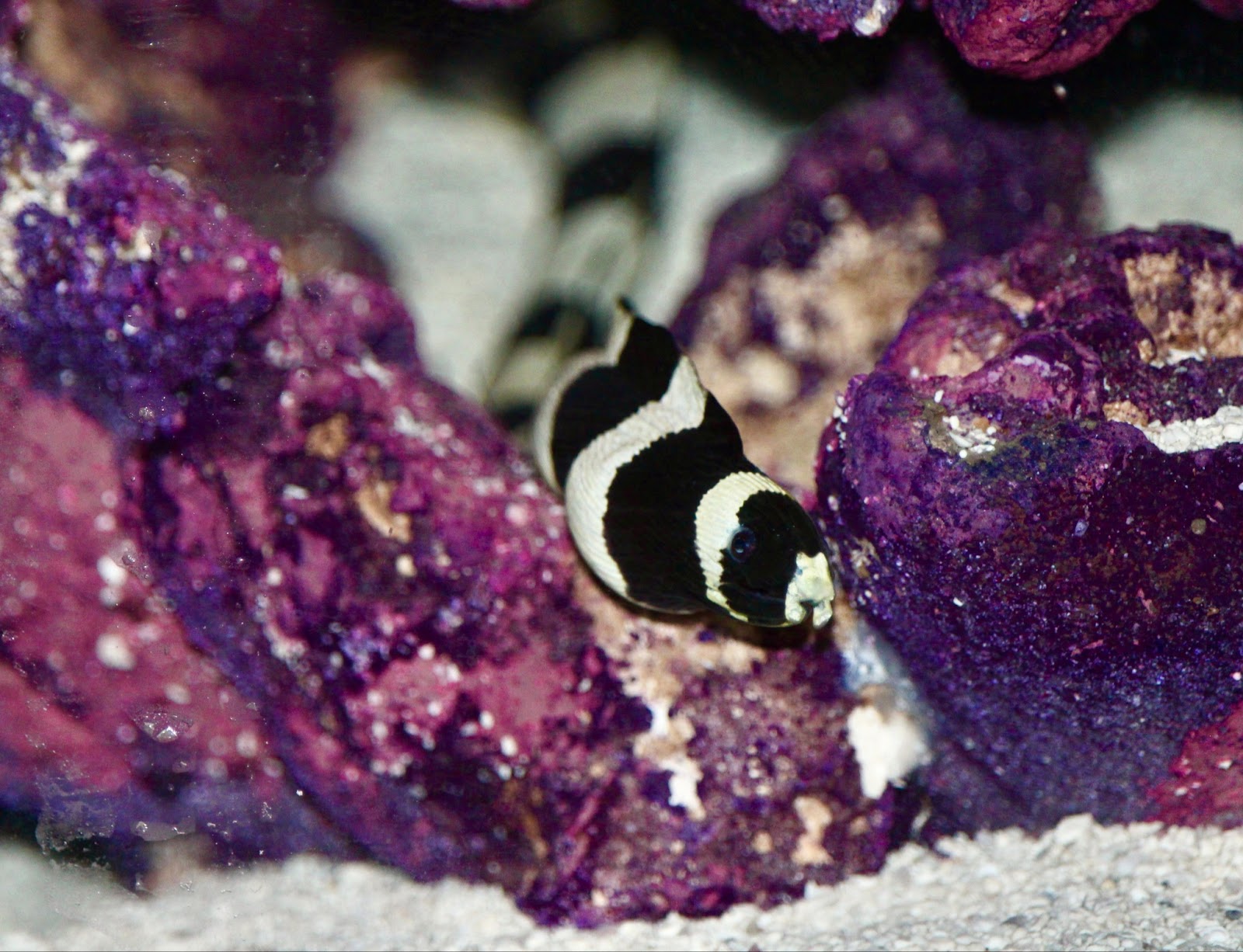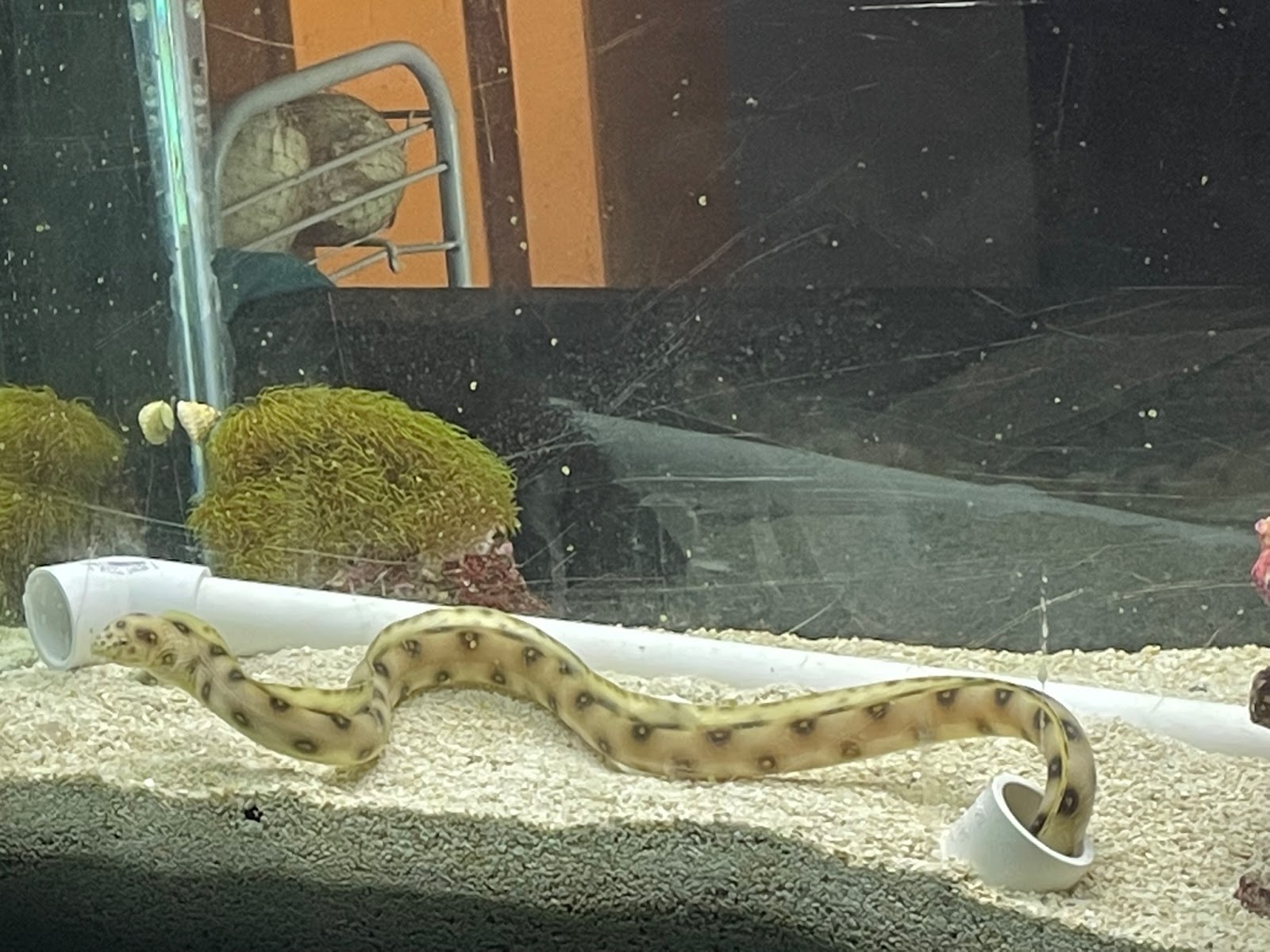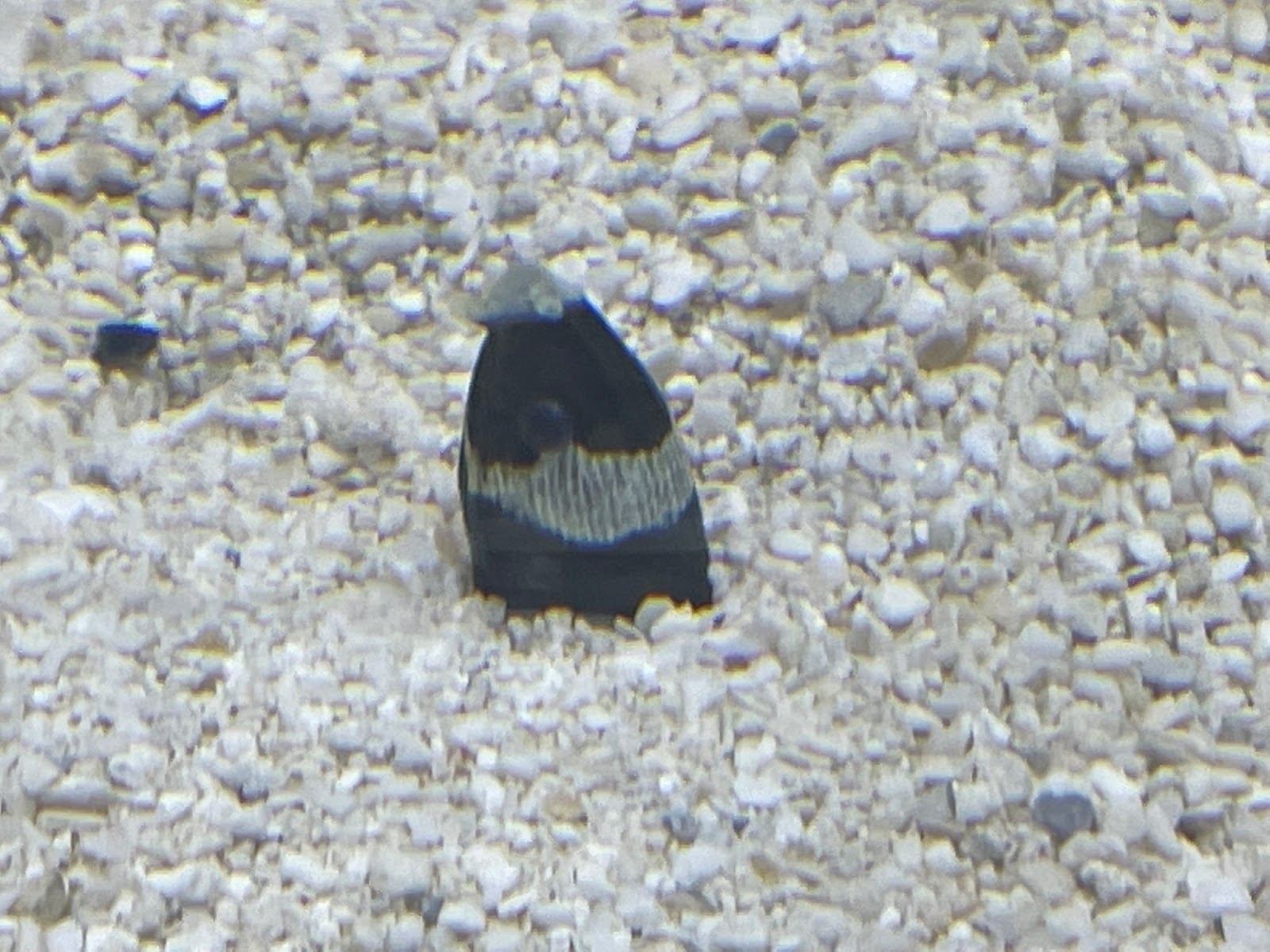Snake Eels

Myrichthys Colubrinus - The Banded Snake Eel
Snake eels are a more rarely seen but available eel in the aquarium hobby but are they a viable option for someone looking for a more unusual eel?

Myrichthys Ocellatus - The Goldspotted Snake Eel
Snake eels are true Eels from the order Anguilliformes like morays but are actually from the family Ophichthidae from the congroidei sub-order. Morays are from the Muraenidae family of the sub-order Muraenoidei. That is to say that snake eels and morays are not that closely related though they are both eels. The most closely related eel to snakes in this hobby are in fact garden eels of the family Heterocongrinae.
That being said, all the snake eels that I know of in the hobby are from the genus Myrichthys which as far as I can tell means “male moray”. This is most likely referring to their similar size, habitat, and behavior. Especially moray eels in the genus Echidna (pebble toothed morays). There are eleven known species of which I own two, Myrichthys colubrinus and Myrichthys ocellatus, and I have seen one other species for sale, Myrichthys pardalis, the Leopard Snake Eel.
Credit: Fab Dive
Aquarium: Snake eels require good water condi
 tions at all of the standard values. They will suffer from osmotic shock so acclimation is important if possible. These eels require either a soft sand bed/mud or some pvc pipe on the bottom. They may spend most of their time in the sand or pipe at first but will gain confidence over time and be more active. When active they will peruse the bottom or take to swimming in the open. To fully enjoy your eel a bigger tank is better as they will be more able to swim. I have never had one escape the tank or attempt to do so but that is no guarantee they won’t do so.
tions at all of the standard values. They will suffer from osmotic shock so acclimation is important if possible. These eels require either a soft sand bed/mud or some pvc pipe on the bottom. They may spend most of their time in the sand or pipe at first but will gain confidence over time and be more active. When active they will peruse the bottom or take to swimming in the open. To fully enjoy your eel a bigger tank is better as they will be more able to swim. I have never had one escape the tank or attempt to do so but that is no guarantee they won’t do so.
Feeding: Diet wise you can feed live or fresh/frozen but probably a combo is best. They will eat live shrimp like ghost shrimp if small enough but will not eat live feeder fish as they cannot catch them. As for prepared food; krill, squid, and other soft seafood is best. All food must be small enough for the eels to swallow whole. They should be fed every day when younger but reduced while they age to every 3 days when near full size. They are less likely to overeat than morays but will throw up if overfed. Food can be fed with tongs or a stick or hands, buried in the sand for them to find, or just dropped in if your eel is a particularly aggressive eater. Due to their lack of vision you may need patience when target feeding them.
Tank Mates: These eels are probably fish safe though I would not trust them with small burrowing fish like small gobies. They are probably not shrimp safe. Treat them like you would a pebble toothed eel. If you can't get a feeding response they do benefit from having other eels who will start a sort of feeding frenzy that will encourage it to eat. They can be bullied and have soft skin only slightly protected by a slime coating. Therefore I would avoid larger and aggressive puffers, triggers, sharks and other similarly aggressive fish. However for the most part these are very fish friendly fish.
Handling: This is an eel you can interact with. They have very dull teeth and weak jaws so even a big one could only cause minor pain and are unlikely to break the skin. In my experience they can be hard to feed sometimes and hand feeding may be the best option. Excessive touching however will ham their slime coating and could damage the eel.
Difficulty: These eels can be quite easy or hard and this comes mainly down to the species and individual eel. My gold-spotted, Myrichthys ocellatus, is as easy as any fish I’ve owned, being tough and eating anything with no difficulty. My banded, Myrichthys colubrinus, is very different, being very sensitive to water quality and requiring very small and therefore numerous bits of seafood to be hand fed.
Behaviorally these are fairly similar in that they are mostly hidden most of the time but will leave their hidey holes occasionally, usually for food. The difference is that snake eels will burrow in the sand or in a pipe in the bottom while morays will prefer to hide under or behind rocks or in any pipe. When active they are roughly the same though morays are far more flexible and able to slip in and out of rocks and other obstacles while snakes seem to be the better swimmers though cannot bend their body nearly as much.
Echidna’s are known for their “dull” teeth and lack of a serious bite. From personal experience they’re bite is far worse than a snake eels. Or rather a snake eel bite is even less harmful than an echidna moray. They don’t seem to have teeth or if they do they are very dull and they’re jaws don’t seem to have very strong jaws either.
Both are known to be mostly fish safe but not crustacean safe and that is also my conclusion. I’d suggest that the snakes are more fish safe and only dangerous to unprotected crustaceans like smaller shrimp like cleaner shrimp due to the lesser bite.
Finally though both have poor vision, the snake eels is significantly worse.
Myrichthys Colubrinus - The Banded Snake Eel
Snake eels are a more rarely seen but available eel in the aquarium hobby but are they a viable option for someone looking for a more unusual eel?
Quick Guide
- Care Level: Moderate
- Aggression: Semi-Aggressive
- Max Size: 3 to 4 ft (90 to 120cm)
- Minimum Tank: 90 gallon
- Lifespan: Unknown but probably decades
- Most Active: Night at first but can be trained to be diurnal
- Diet: Small crustaceans and mollusks
Myrichthys Ocellatus - The Goldspotted Snake Eel
Taxonomy
| Kingdom: | Animalia |
| Phylum: | Chordata |
| Class: | Actinopterygii |
| Order: | Anguilliformes |
| Family: | Ophichthidae |
| Genus: | Myrichthys |
Snake eels are true Eels from the order Anguilliformes like morays but are actually from the family Ophichthidae from the congroidei sub-order. Morays are from the Muraenidae family of the sub-order Muraenoidei. That is to say that snake eels and morays are not that closely related though they are both eels. The most closely related eel to snakes in this hobby are in fact garden eels of the family Heterocongrinae.
That being said, all the snake eels that I know of in the hobby are from the genus Myrichthys which as far as I can tell means “male moray”. This is most likely referring to their similar size, habitat, and behavior. Especially moray eels in the genus Echidna (pebble toothed morays). There are eleven known species of which I own two, Myrichthys colubrinus and Myrichthys ocellatus, and I have seen one other species for sale, Myrichthys pardalis, the Leopard Snake Eel.
In the Wild
Snake eels live in the tropical oceans of the Indian, Pacific, and western Atlantic oceans. These eels are burrowers who both sleep and hide in the sand or mud and will also hunt there too. They’re nostrils are pointed downward allowing them to swim above the bottom smelling for food. When they find it they will dive into the sand and try to grab their prey. They have relatively weak jaws and very dull teeth (even compared to pebble toothed morays) which means they cannot catch or kill the fish nor tough crustaceans that live openly in the ocean but instead go for softer and slower prey that is hidden in places most predators can’t find or get to. This is also why they’re vision is awful as they have no need for it when hunting in the sand at night instead they rely almost completely on smell and feel. To avoid predation most snake eels will hide in the sand however the banded or harlequin snake eel Myrichthys colubrinus has evolved to look like the very venomous sea snakes and kraits that it shares its habitat with. Snake eels however are not venomous themselves. Like many eels, reproduction is not well known.Credit: Fab Dive
In the Aquarium
Aquarium: Snake eels require good water condi
Feeding: Diet wise you can feed live or fresh/frozen but probably a combo is best. They will eat live shrimp like ghost shrimp if small enough but will not eat live feeder fish as they cannot catch them. As for prepared food; krill, squid, and other soft seafood is best. All food must be small enough for the eels to swallow whole. They should be fed every day when younger but reduced while they age to every 3 days when near full size. They are less likely to overeat than morays but will throw up if overfed. Food can be fed with tongs or a stick or hands, buried in the sand for them to find, or just dropped in if your eel is a particularly aggressive eater. Due to their lack of vision you may need patience when target feeding them.
Tank Mates: These eels are probably fish safe though I would not trust them with small burrowing fish like small gobies. They are probably not shrimp safe. Treat them like you would a pebble toothed eel. If you can't get a feeding response they do benefit from having other eels who will start a sort of feeding frenzy that will encourage it to eat. They can be bullied and have soft skin only slightly protected by a slime coating. Therefore I would avoid larger and aggressive puffers, triggers, sharks and other similarly aggressive fish. However for the most part these are very fish friendly fish.
Handling: This is an eel you can interact with. They have very dull teeth and weak jaws so even a big one could only cause minor pain and are unlikely to break the skin. In my experience they can be hard to feed sometimes and hand feeding may be the best option. Excessive touching however will ham their slime coating and could damage the eel.
Difficulty: These eels can be quite easy or hard and this comes mainly down to the species and individual eel. My gold-spotted, Myrichthys ocellatus, is as easy as any fish I’ve owned, being tough and eating anything with no difficulty. My banded, Myrichthys colubrinus, is very different, being very sensitive to water quality and requiring very small and therefore numerous bits of seafood to be hand fed.
In Comparison
If thinking about a snake eel it’s probably best to compare it to its closest behaviorally and far more common alternatives: echidna or pebble toothed moray eels such as the snowflake eel, Echidna nebulosa.Behaviorally these are fairly similar in that they are mostly hidden most of the time but will leave their hidey holes occasionally, usually for food. The difference is that snake eels will burrow in the sand or in a pipe in the bottom while morays will prefer to hide under or behind rocks or in any pipe. When active they are roughly the same though morays are far more flexible and able to slip in and out of rocks and other obstacles while snakes seem to be the better swimmers though cannot bend their body nearly as much.
Echidna’s are known for their “dull” teeth and lack of a serious bite. From personal experience they’re bite is far worse than a snake eels. Or rather a snake eel bite is even less harmful than an echidna moray. They don’t seem to have teeth or if they do they are very dull and they’re jaws don’t seem to have very strong jaws either.
Both are known to be mostly fish safe but not crustacean safe and that is also my conclusion. I’d suggest that the snakes are more fish safe and only dangerous to unprotected crustaceans like smaller shrimp like cleaner shrimp due to the lesser bite.
Finally though both have poor vision, the snake eels is significantly worse.
Summary
If you’re looking for an impressive and mostly reef safe eel or just something different this definitely something you should consider. Comparatively reef safe, less likely to escape, and with a different unique build these are great fish. I think the only real downside to them is the lack of information on keeping them. When researching mine The only care guide I found turned out to be fairly useless as it lacked basic understanding of how these animals live in the wild. One of the hardest things I had writing this was to do with how different my two eels are despite being from the same genus and of course having such a small sample size. Still I believe I have captured the essence of them and can help anyone considering getting one of these amazing beasts.
Last edited:












